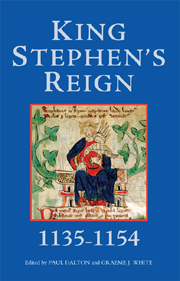Book contents
- Frontmatter
- Contents
- List of Maps
- Preface
- Abbreviations
- Genealogical Table
- Introduction
- 1 Henry I and the Origins of the Civil War
- 2 Royal Income and Regional Trends
- 3 King Stephen and Northern France
- 4 A Week in Politics: Oxford, late July 1141
- 5 Allegiance and Intelligence in King Stephen's Reign
- 6 English Monasteries and the Continent in the Reign of King Stephen
- 7 Reeds Shaken by the Wind? Bishops in Local and Regional Politics in King Stephen's Reign
- 8 Violent Disorder in King Stephen's England: A Maximum Argument
- 9 The Lure of Stephen's England: Tenserie, Flemings and a Crisis of Circumstance
- 10 Legal Treatises as Perceptions of Law in Stephen's Reign
- Index
10 - Legal Treatises as Perceptions of Law in Stephen's Reign
Published online by Cambridge University Press: 12 September 2012
- Frontmatter
- Contents
- List of Maps
- Preface
- Abbreviations
- Genealogical Table
- Introduction
- 1 Henry I and the Origins of the Civil War
- 2 Royal Income and Regional Trends
- 3 King Stephen and Northern France
- 4 A Week in Politics: Oxford, late July 1141
- 5 Allegiance and Intelligence in King Stephen's Reign
- 6 English Monasteries and the Continent in the Reign of King Stephen
- 7 Reeds Shaken by the Wind? Bishops in Local and Regional Politics in King Stephen's Reign
- 8 Violent Disorder in King Stephen's England: A Maximum Argument
- 9 The Lure of Stephen's England: Tenserie, Flemings and a Crisis of Circumstance
- 10 Legal Treatises as Perceptions of Law in Stephen's Reign
- Index
Summary
J. H. ROUND's account of the burial of Geoffrey de Mandeville provides us with a point of departure for a discussion of law and its recorders in the reign of King Stephen. Geoffrey's body, Round tells us, was, according to one account, wrapped in lead and hung from a fruit tree in the Old Temple's burial ground, where it dangled for twenty years until the earl was allowed a Christian burial. Round underlined the irony of Geoffrey's gravesite: ‘around the nameless resting-place of the great champion of anarchy, there was destined to rise, in later days, the home of English law’. Here we see the perfect counterpoint – disorder and law; the one giving birth to the other; their symbiotic relationship symbolized by body and gravesite. Both ends of Round's irony are based on misperceptions. English law did not begin at the Temple, nor was Geoffrey so typical of the violent and lawless barons of the Anarchy. English law – the written tradition recording it – had begun with the first Anglo-Saxon kings to convert to Christianity in the early seventh century. Rebellious barons may have rejected royal authority as had Geoffrey de Mandeville, but when called upon to govern their territories, did so at times with remarkably royal best practices.
The irony, nevertheless, appeared clearer to Round than to us because, although a critical reader of charters of Stephen's reign, he was an uncritical user of the chronicles, and so without filter repeated their prejudices and distortions. To cite only one of countless instances, consider Round's description of Geoffrey's actions at Ramsey and Ely in 1144.
- Type
- Chapter
- Information
- King Stephen's Reign (1135–1154) , pp. 182 - 196Publisher: Boydell & BrewerPrint publication year: 2008

